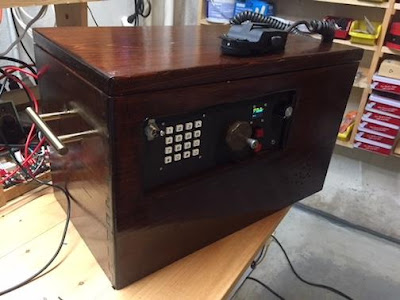'Tis a thing of beauty. I like the wood. And I like the hood. The handles are a nice touch. A fitting follow-up to its al fresco organic origins.
Hi Guys:
I know there was a view that my giant BITX was supposed to be left out in the open, but I’m going to try to attend my local club’s Field Day festivities this year and the 4 foot long “planker” was pressing the limits of portability. So I moved from the shack to the wood shop and built myself some custom cabinetry. I think it looks a bit like an IC-73000 now don’t you think? OK, maybe not.
There is a hinged door at the top and shelf levels inside for the different parts of the circuit. The power supply and PA section are mounted on the bottom which can be removed for accessibility/serviceability. The whole thing weighs about 10 pounds!!
73s,
Bruce KC1FSZ


































